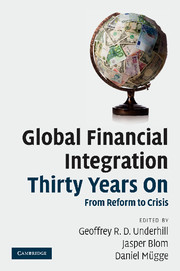Book contents
- Frontmatter
- Contents
- List of figures
- List of tables
- Notes on contributors
- Preface
- Acknowledgements
- List of abbreviations
- Introduction: the challenges and prospects of global financial integration
- Part I History and context: input, output and the current architecture (whence it came)
- Part II Assessing the current financial architecture (how well does it work?)
- Part III Does the future hold? Reactions to the current regime and prospects for progress (where is it going?)
- 12 Changing transatlantic financial regulatory relations at the turn of the millennium
- 13 Monetary and financial cooperation in Asia: improving legitimacy and effectiveness?
- 14 From microcredit to microfinance to inclusive finance: a response to global financial openness
- 15 Combating pro-cyclicality in the international financial architecture: towards development-friendly financial governance
- 16 Public interest, national diversity and global financial governance
- Conclusion: whither global financial governance after the crisis?
- References
- Index
16 - Public interest, national diversity and global financial governance
Published online by Cambridge University Press: 02 December 2010
- Frontmatter
- Contents
- List of figures
- List of tables
- Notes on contributors
- Preface
- Acknowledgements
- List of abbreviations
- Introduction: the challenges and prospects of global financial integration
- Part I History and context: input, output and the current architecture (whence it came)
- Part II Assessing the current financial architecture (how well does it work?)
- Part III Does the future hold? Reactions to the current regime and prospects for progress (where is it going?)
- 12 Changing transatlantic financial regulatory relations at the turn of the millennium
- 13 Monetary and financial cooperation in Asia: improving legitimacy and effectiveness?
- 14 From microcredit to microfinance to inclusive finance: a response to global financial openness
- 15 Combating pro-cyclicality in the international financial architecture: towards development-friendly financial governance
- 16 Public interest, national diversity and global financial governance
- Conclusion: whither global financial governance after the crisis?
- References
- Index
Summary
Radical reforms of the international financial architecture were urgently discussed following the outbreak of currency and financial crises in East Asia and other emerging market economies in the late 1990s. By the time the Argentine and Turkish crises erupted in 2000–1, the broad contours of the post-Asian crisis global financial architecture were set. The reforms had been limited to a focus on technical deficiencies in the functioning of markets. The Introduction and several chapters in this volume argued that this pattern of governance reflected the preferences of an alliance of powerful transnational market players and the official national and multilateral agencies of financial and monetary governance based in advanced industrial countries, economies which had hitherto avoided most of the consequences of financial instability experienced by developing economies. A range of chapters also argued and presented evidence that the current financial architecture lacks effectiveness and suffers legitimacy problems on both the input and output sides of the equation, and that limited participation on the input side was related to ineffectual and illegitimate policy output.
The post-2001 period of relative calm ended with the outbreak of the sub-prime crisis in 2007. This serious crisis at the heart of the global financial system, occurring despite the reform of the financial architecture and beginning in the most robust financial systems, should stimulate urgent reflection on the nature of contemporary financial governance.
- Type
- Chapter
- Information
- Global Financial Integration Thirty Years OnFrom Reform to Crisis, pp. 287 - 303Publisher: Cambridge University PressPrint publication year: 2010
- 1
- Cited by

